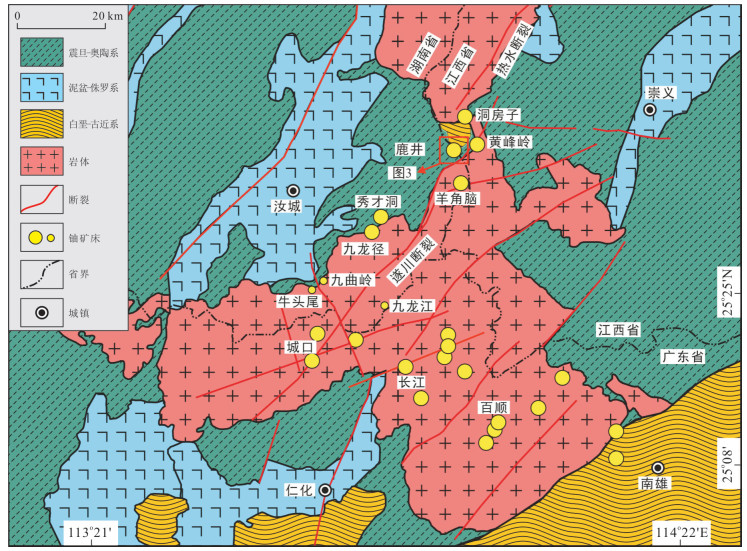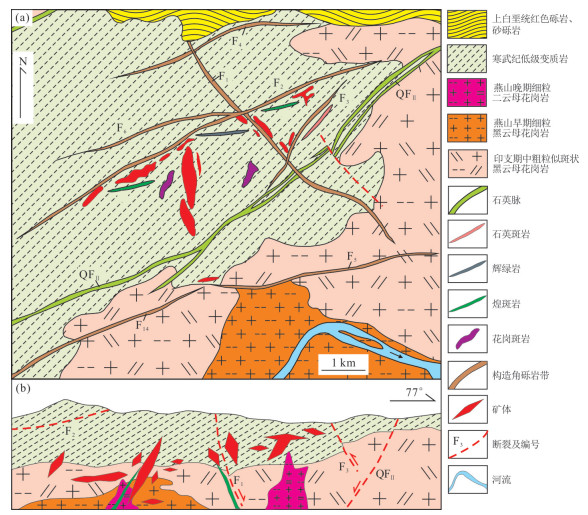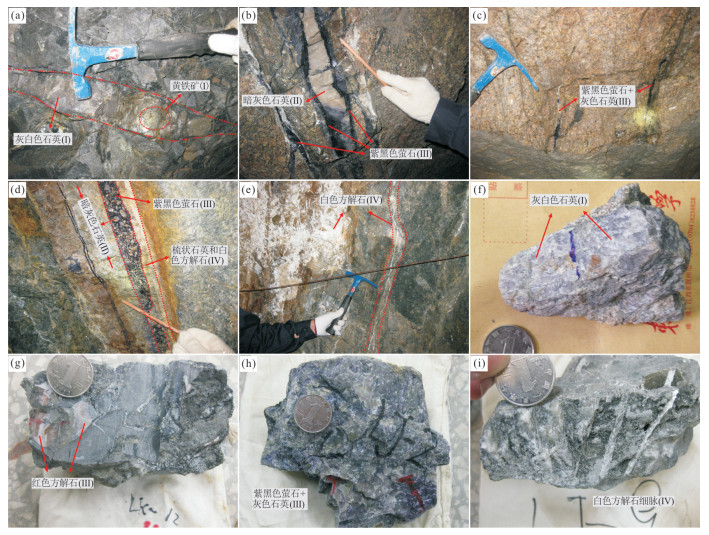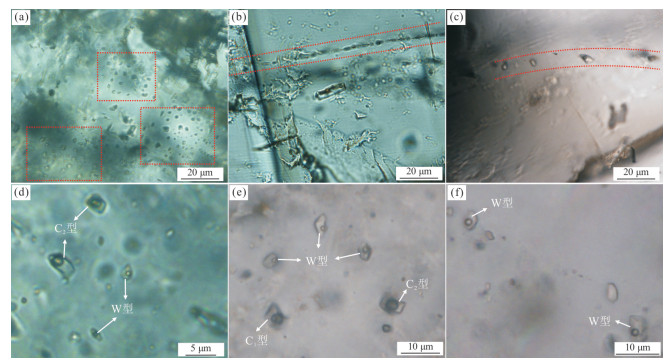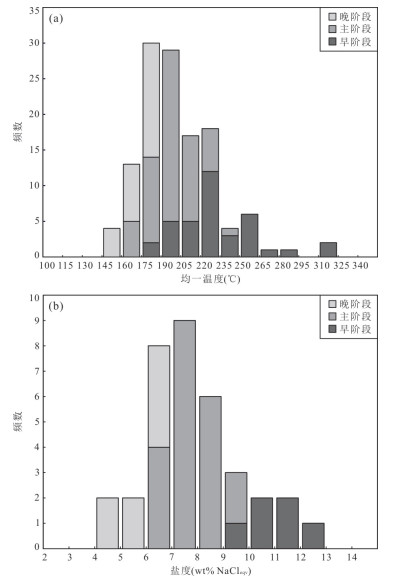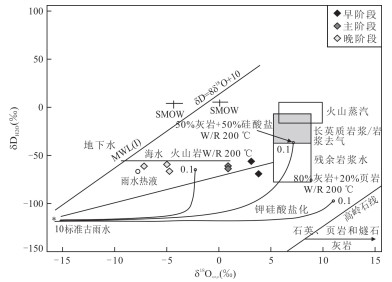Fluid Inclusion Constraints on Ore-Forming Mechanism of Lujing Uranium Deposit in Jiangxi-Hunan Border Region
-
摘要:
位于南岭成矿带南西部的鹿井矿床是华南热液型铀矿的典型代表. 为查明其成矿流体来源、性质与演化以及成矿机制,开展了不同成矿阶段石英、萤石及方解石中流体包裹体的显微测温和不同阶段石英的氢-氧同位素分析. 矿床地质特征表明成矿过程可划分为(Ⅰ)粗晶石英+黄铁矿±绿泥石±绢云母、(Ⅱ)沥青铀矿+硫化物+绿泥石+绢云母+暗灰色微晶石英、(Ⅲ)紫黑色萤石+肉红色方解石+灰色微晶石英+赤铁矿+铀石±黄铁矿和(Ⅳ)梳状石英+浅色萤石+白色方解石四个阶段;其中阶段Ⅱ和Ⅲ代表成矿主阶段. 成矿早阶段和主阶段捕获水溶液包裹体和少量含CO2包裹体,而晚阶段仅见水溶液包裹体. 早、主、晚阶段包裹体的均一温度依次为186~317、169~236、149~189℃,盐度依次为9.9~12.9、6.3~9.9、4.5~7.0 wt% NaCleqv. 成矿流体自早阶段至晚阶段逐渐由中低温、中低盐度的NaCl-H2O-CO2体系演化为低温、低盐度的NaCl-H2O体系,期间由压力降低引发的流体沸腾作用是重要的成矿机制. H-O同位素数据表明,初始成矿流体来自岩浆水与大气降水的混合,成矿过程伴随着大气降水的持续加入.
Abstract:The Lujing uranium deposit located in the southwestern part of the Nanling metallogenic belt is a representative granite-related hydrothermal uranium deposit in South China. In this paperit presents new detailed fluid inclusion and H-O isotope data to constrain the source, nature, and evolution of the ore-forming fluids and reveal the ore-forming mechanism. Four stages of mineralization have been identified in the Lujing deposit: (Ⅰ) macrocrystalline quartz+pyrite+chlorite+sericite, (Ⅱ) pitchblende+sulfide+chlorite+sericite+microcrystalline quartz, (Ⅲ) purple-black fluorite+reddish calcite+microcrystalline quartz+hematite+coffinite+pyrite, and (Ⅳ) comb quartz+light-green fluorite+white calcite. The stages Ⅱ and Ⅲ represent the main uranium mineralization. The early and main stages of mineralization contain aqueous inclusions and a small amount of CO2-bearing inclusions, whereas the late stage of mineralization contains only aqueous inclusions. The fluid inclusions in early-stage quartz have homogenization temperature of 186-317 ℃ and salinities of 9.9-12.9 wt% NaCleqv. The fluid inclusions in the quartz, fluorite, and calcite forming the main stage have homogenization temperatures of 169-236 ℃ and salinities of 6.3-9.9 wt% NaCleqv. The fluid inclusions in late-stage quartz, fluorite, and calcite have homogenization temperatures of 149-189 ℃ and salinities of 4.5-7.0 wt% NaCleqv. The ore-forming fluid system evolved from a CO2-H2O-NaCl system in the early stage to a NaCl-H2O system in the late stage. Fluid boiling was the dominant mechanism for uranium precipitation. The H-O isotope results indicate that the initial ore-forming fluid is the mixture of magmatic water and meteoric water, and the meteoric water was continuously added to the ore-forming fluids during mineralization.
-
Key words:
- fluid inclusion /
- ore-forming fluid /
- uranium deposit /
- Lujing /
- Zhuguangshan /
- mineral deposit
-
图 1 研究区大地构造位置示意图(据张敏等,2006修改)
Fig. 1. Tectonic position of the study area (modified from Zhang et al., 2006)
图 3 鹿井铀矿床地质简图(a)与剖面示意图(b)(据邵飞等,2013修改)
Fig. 3. Geological sketch map of the Lujing uranium deposit (a) and schematic geologic section of Lujing uranium deposit (b) (modified from Shao et al., 2013)
图 8 鹿井矿床成矿流体的δ18$ {\mathrm{O}}_{{\mathrm{H}}_{2}\mathrm{O}}\mathrm{-}\mathtt{δ}{\mathrm{D}}_{{\mathrm{H}}_{2}\mathrm{O}} $图解(据Taylor,1997)
Fig. 8. δ18$ {\mathrm{O}}_{{\mathrm{H}}_{2}\mathrm{O}}\mathrm{-}\mathtt{δ}{\mathrm{D}}_{{\mathrm{H}}_{2}\mathrm{O}} $ plot of ore-forming fluids from the Lujing deposit (from Taylor, 1997)
表 1 鹿井矿床流体包裹体显微测温数据
Table 1. Microthermometric data for fluid inclusions of the Lujing deposit
成矿阶段 测试矿物 类型 数量(个) 大小(μm) Tm, ice(℃) Th, TOT(℃) 盐度(wt% NaCleqv) 密度(g/cm3) 早阶段 石英 W 37 3~10 -9.0 ~ -6.5 186~317 9.9~12.9 0.86~0.97 主阶段 紫黑色萤石、肉红色方解石 W 60 5~10 -6.5 ~ -3.9 169~236 6.3~9.9 0.86~0.95 晚阶段 浅色萤石、白色方解石 W 29 3~12 -4.4 ~ -2.7 149~189 4.5~7.0 0.90~0.95 注:Tm, ice为冰点温度,Th, TOT为完全均一温度. 表 2 鹿井矿床各成矿阶段石英的H-O同位素组成
Table 2. Hydrogen and oxygen isotopic compositions of fluid inclusions in quartz samples from the Lujing deposit
序号 样号 成矿阶段 δD (‰) δ18Oquartz (‰) T (℃) δ18$ {\mathrm{O}}_{{\mathrm{H}}_{2}\mathrm{O}} $ (‰) 1 LK5-1 早阶段 -68.8 13.6 233 3.8 2 1002 -56.3 12.9 3.1 3 LK5-2 主阶段 -63.5 12.7 198 0.9 4 LK-11 -60.6 12.7 0.9 5 XD-3 晚阶段 -65.7 8.7 174 -4.8 6 LJ-7 -59.1 8.5 -5.0 7 LK-16 -60.9 6.3 -7.2 注:测试样品均为石英;T代表各成矿阶段包裹体的平均均一温度. -
Anderson, M. R., Rankin, A. H., Spiro, B., 1992. Fluid Mixing in the Generation of Mesothermal Gold Mineralisation in the Transvaal Sequence, Transvaal, South Africa. European Journal of Mineralogy, 4(5): 933-948. https://doi.org/10.1127/ejm/4/5/0933 Bodnar, R. J., 1983. A Method of Calculating Fluid Inclusion Volumes Based on Vapor Bubble Diameters and P-V-T-X Properties of Inclusion Fluids. Economic Geology, 78(3): 535-542. https://doi.org/10.2113/gsecongeo.78.3.535 Chai, P., Sun, J. G., Xing, S. W., et al., 2016. Ore Geology, Fluid Inclusion and 40Ar/39Ar Geochronology Constraints on the Genesis of the Yingchengzi Gold Deposit, Southern Heilongjiang Province, NE China. Ore Geology Reviews, 72: 1022-1036. https://doi.org/10.1016/j.oregeorev.2015.09.026 Chai, P., Hou, Z. Q., Zhang, H. R., et al., 2019a. Geology, Fluid Inclusion, and H-O-S-Pb Isotope Constraints on the Mineralization of the Xiejiagou Gold Deposit in the Jiaodong Peninsula. Geofluids, 1-23. https://doi.org/10.1155/2019/3726465 Chai, P., Zhang, H. R., Dong, L. L., et al., 2019b. Geology and Ore-Forming Fluids of the Dayingezhuang Gold Deposit, Jiaodong Peninsula, Eastern China: Implications for Mineral Exploration. Journal of Geochemical Exploration, 204: 224-239. https://doi.org/10.1016/j.gexplo.2019.06.001 Chai, P., Zhang, H. R., Hou, Z. Q., et al., 2020. Ore Geology, Fluid Inclusion, and Stable Isotope Constraints on the Origin of the Damoqujia Gold Deposit, Jiaodong Peninsula, China. Canadian Journal of Earth Sciences, 57(12): 1428-1446. https://doi.org/10.1139/cjes-2018-0247 Chen, X.D., Liu, X., Deng, G.Q., et al., 2002. Mesozoic- Cenozoic Continental Strike-Slip Fault System and Its Roles on Uranium Mineralization in Hunan and Guangxi, China. Geotectonica et Metallogenia, 26(4): 345-353 (in Chinese with English abstract). Clayton, R. N., O'Neil, J. R., Mayeda, T. K., 1972. Oxygen Isotope Exchange between Quartz and Water. Journal of Geophysical Research, 77(17): 3057-3067. https://doi.org/10.1029/jb077i017p03057 Deng, P., Ren, J. S., Ling, H. F., et al., 2012. SHRIMP Zircon U-Pb Ages and Tectonic Implications for Indosinian Granitoids of Southern Zhuguangshan Granitic Composite, South China. Chinese Science Bulletin, 57(13): 1542-1552. https://doi.org/10.1007/s11434-011-4951-8 Han, J., Wang, Y.B., Wang, D.H., et al., 2011. Age and Genesis of the Granite in the Huangfengling Uranium Deposit, Jiangxi Province: Evidence from Zircon U-Pb Dating and Hf Isotopes. Geology and Exploration, 47(2): 284-293 (in Chinese with English abstract). Hu, R.Z., Bi, X.W., Peng, J.T., et al., 2007. Some Problems Concerning Relationship between Mesozoic-Cenozoic Lithospheric Extension and Uranium Metallogenesis in South China. Mineral Deposits, 26(2): 139-152 (in Chinese with English abstract). Hu, R.Z., Bi, X.W., Su, W.C., et al., 2004. The Relationship between Uranium Metallogenesis and Crustal Extension during the Cretaceous-Tertiary in South China. Earth Science Frontiers, 11(1): 153-160 (in Chinese with English abstract). Hu, R. Z., Bi, X. W., Zhou, M. F., et al., 2008. Uranium Metallogenesis in South China and Its Relationship to Crustal Extension during the Cretaceous to Tertiary. Economic Geology, 103(3): 583-598. https://doi.org/10.2113/gsecongeo.103.3.583 Jiang, H.A., Zou, M.L., Ouyang, P.N., et al., 2020. 40Ar-39Ar Age of the Late Stage Veins in Central Zhuguangshan Pluton of South China and Its Relationship with Uranium Metallogenesis. Geological Bulletin of China, 39(5): 728-734 (in Chinese with English abstract). Li, J.W., Li, Z.J., Fu, Z.R., et al., 2000. Heat Sources and Hydrothermal Uranium Mineralization in the Suichuan-Reshui Strike-Slip Fault Zone. Geological Science and Technology Information, 19(3): 39-43 (in Chinese with English abstract). Li, L., Sun, J. G., Men, L. J., et al., 2016. Origin and Evolution of the Ore-Forming Fluids of the Erdaogou and Xiaobeigou Gold Deposits, Jiapigou Gold Province, NE China. Journal of Asian Earth Sciences, 129: 170-190. https://doi.org/10.1016/j.jseaes.2016.08.009 Li, X.F., Li, J.W., Fu, Z.R., 1999. Uranium Mineralization Related to Strike-Slip Faults, Lujing Orefield, Border Region between Eastern Hunan and Western Jiangxi. Earth Science, 24(5): 476-479 (in Chinese with English abstract). Li, X. H., 2000. Cretaceous Magmatism and Lithospheric Extension in Southeast China. Journal of Asian Earth Sciences, 18(3): 293-305. https://doi.org/10.1016/s1367-9120(99)00060-7 Li, X.H., Hu, R.Z., Rao, B., 1997. Geochronology and Geochemistry of Cretaceous Mafic Dikes from Northern Guangdong, SE China. Geochimica, 26(2): 14-31 (in Chinese with English abstract). Li, Z.J., Fu, Z.R., Li, J.W., 1998. Dynamic System Analysis of Metallogenesis of NNE-Trending Strike-Slip Fault-Fluid-Uranium Mineralization in Hunan-Jiangxi Border Region. Geoscience, 12(4): 522-531 (in Chinese with English abstract). Ling, H.F., 2011. Origin of Hydrothermal Fluids of Granite-Type Uranium Deposits: Constraints from Redox Conditions. Geological Review, 57(2): 193-206 (in Chinese with English abstract). https://en.cnki.com.cn/Article_en/CJFDTOTAL-DZLP201102005.htm Liu, H.B., Jin, G.S., Li, J.J., et al., 2013. Determination of Stable Isotope Composition in Uranium Geological Samples. World Nuclear Geoscience, 30(3): 174-179 (in Chinese with English abstract). https://en.cnki.com.cn/Article_en/CJFDTOTAL-GWYD201303011.htm Lu, H.Z., 2008. Role of CO2 Fluid in the Formation of Gold Deposits: Fluid Inclusion Evidences. Geochimica, 37(4): 321-328 (in Chinese with English abstract). Lu, H.Z., Fan, H.R., Ni, P., et al., 2004. Fluid Inclusions. Science Press, Beijing (in Chinese). Luo, J. C., Hu, R. Z., Fayek, M., et al., 2015a. In-Situ SIMS Uraninite U-Pb Dating and Genesis of the Xianshi Granite-Hosted Uranium Deposit, South China. Ore Geology Reviews, 65: 968-978. https://doi.org/10.1016/j.oregeorev.2014.06.016 Luo, J. C., Hu, R. Z., Shi, S. H., 2015b. Timing of Uranium Mineralization and Geological Implications of Shazijiang Granite-Hosted Uranium Deposit in Guangxi, South China: New Constraint from Chemical U-Pb Age. Journal of Earth Science, 26(6): 911-919. https://doi.org/10.1007/s12583-015-0542-y Luo, Y., Wang, M.T., Li, J.H., et al., 2002. Geological Characteristics and Metallogenetic Model of Zhuguang Uranium Ore Concentrated Area. China Nuclear Science and Technology Report, (1): 220-235 (in Chinese with English abstract). Ma, W., Liu, Y.C., Yang, Z.S., et al., 2019. Characteristics of Ore-Forming Fluids of Lietinggang-Leqingla Pb-Zn-Fe-Cu-Mo Polymetallic Deposit in Tibetan: Evidence from Fluid Inclusions and Stable Isotope Compositions. Earth Science, 44(6): 1957-1973 (in Chinese with English abstract). Mao, J.W., Xie, G.Q., Li, X.F., et al., 2004. Mesozoic Large Scale Mineralization and Multiple Lithospheric Extension in South China. Earth Science Frontiers, 11(1): 45-55 (in Chinese with English abstract). https://www.researchgate.net/publication/307904169_Mesozoic_large_scale_mineralization_and_multiple_lithospheric_extension_in_South_China Min, M. Z., Luo, X. Z., Du, G. S., et al., 1999. Mineralogical and Geochemical Constraints on the Genesis of the Granite-Hosted Huangao Uranium Deposit, SE China. Ore Geology Reviews, 14(2): 105-127. https://doi.org/10.1016/s0169-1368(98)00020-1 Ohmoto, H., 1986. Stable Isotope Geochemistry of Ore Deposits. Reviews in Mineralogy and Geochemistry, 16(6): 491-559. Roedder, E., 1984. Fluid Inclusions. In: Ribbe, P.H., ed., Reviews in Mineralogy. Mineralogical Society of American, Michigan. Shao, F., Xu, J.J., Mao, Y.F., et al., 2013. Study on Mineral Discharge Mechanism of Granite Type Uranium Deposits in South China Uranium Metallogenic Province. Uranium Geology, 29(3): 146-151, 171 (in Chinese with English abstract). Shao, F., Zhu, Y.G., Guo, H.S., et al., 2010. Analysis on Geological Characteristics of Uranium Metallization and Prospecting Potential in Lujing Orefield. Uranium Geology, 26(5): 295-300 (in Chinese with English abstract). Sheppard, S.M.F., 1986. Characterization and Isotopic Variations in Natural Waters. Reviews in Mineralogy and Geochemistry, 16(3): 165-183. Taylor, H.P., 1997. Oxygen and Hydrogen Isotope Relationships in Hydrothermal Mineral Deposits. In: Barnes, H.L., ed., Geochemistry of Hydrothermal Ore Deposits. John Wiley, New York. Wang, M.T., Luo, Y., Sun, Z.F., et al., 1999. Discussion on Genesis of Uranium Deposits in Zhuguang Uranium Metallogenic Region. Uranium Geology, 15(5): 279-285 (in Chinese with English abstract). Wang, Z. G., Wang, K. Y., Wan, D., et al., 2017. Genesis of the Tianbaoshan Pb-Zn-Cu-Mo Polymetallic Deposit in Eastern Jilin, NE China: Constraints from Fluid Inclusions and C-H-O-S-Pb Isotope Systematics. Ore Geology Reviews, 80: 1111-1134. https://doi.org/10.1016/j.oregeorev.2016.08.026 Wang, Z. L., Yang, L. Q., Guo, L. N., et al., 2015. Fluid Immiscibility and Gold Deposition in the Xincheng Deposit, Jiaodong Peninsula, China: A Fluid Inclusion Study. Ore Geology Reviews, 65: 701-717. https://doi.org/10.1016/j.oregeorev.2014.06.006 Xavier, R. P., Foster, R. P., 1999. Fluid Evolution and Chemical Controls in the Fazenda Maria Preta (FMP) Gold Deposit, Rio Itapicuru Greenstone Belt, Bahia, Brazil. Chemical Geology, 154(1-4): 133-154. https://doi.org/10.1016/s0009-2541(98)00128-4 Xie, G. Q., Hu, R. Z., Mao, J. W., et al., 2006. K-Ar Dating, Geochemical, and Sr-Nd-Pb Isotopic Systematics of Late Mesozoic Mafic Dikes, Southern Jiangxi Province, Southeast China: Petrogenesis and Tectonic Implications. International Geology Review, 48(11): 1023-1051. https://doi.org/10.2747/0020-6814.48.11.1023 Yang, S.H., 2008. Uranium Metallogenic Features and Prospecting Potentialities in the Areas around Shabazi Uranium Deposit in Nanling Metallogenic Belt. World Nuclear Geoscience, 25(4): 195-202 (in Chinese with English abstract). Zhang, M., Chen, P.R., Chen, W.F., 2006. Uranium Metallogenic Characteristics and Discussion on Metallogenic Setting of Uranium Plutons in Northern Guangdong Province. Geology of Chemical Minerals, 28(1): 9-14 (in Chinese with English abstract). Zhang, W.L., He, X.M., Lü, C., et al., 2011. Analysis on the Metallogenic Feature and Ore-Controlling Factors in Lujing Uranium Orefield. Uranium Geology, 27(2): 81-87 (in Chinese with English abstract). Zhang, W.L., Lü, C., Wei, J.W., 2010. Analysis on the Metallogenic Feature and Genesis of Lujing Uranium Ore-Field. Mineral Deposits, 29(S1): 162-164 (in Chinese). Zhang, X. T., Pan, J. Y., Xia, F., et al., 2018. Genesis and Metallogenic Process of the Lujing Uranium Deposit, Southwest Jiangxi Province, China: Constraints of Micropetrography and S-C-O Isotopes. Resource Geology, 68(3): 303-325. https://doi.org/10.1111/rge.12171 Zhang, X. T., Sun, J. G., Han, J. L., et al., 2021. Genesis and Ore-Forming Process of the Benqu Mesothermal Gold Deposit in the Jiapigou Ore Cluster, NE China: Constraints from Geology, Geochronology, Fluid Inclusions, and Whole-Rock and Isotope Geochemistry. Ore Geology Reviews, 130: 103956. https://doi.org/10.1016/j.oregeorev.2020.103956 Zhang, Z.H., Li, S.C., Jian, X.P., 1999. Analysis on Space Emplacement Condition of Lujing Uranium Ore Field. Uranium Geology, 15(6): 338-343 (in Chinese with English abstract). Zhao, J. H., Hu, R. Z., Liu, S., 2004. Geochemistry, Petrogenesis, and Tectonic Significance of Mesozoic Mafic Dikes, Fujian Province, Southeastern China. International Geology Review, 46(6): 542-557. https://doi.org/10.2747/0020-6814.46.6.542 Zhong, F.J., Pan, J.Y., Wu, J.H., et al., 2019. Petrogenesis and Its Relationship with Uranium Mineralization of Gabbro-Diorite in Changjiang Uranium Ore-Field, Northern Guangdong Province, China. Earth Science, 44(9): 3042-3059 (in Chinese with English abstract). Zhu, B., 2010. The Study of Mantle Liquid and Uranium Metallogenesis-Take Uranium Ore Field of South Zhuguang Mountain as an Example (Dissertation). Chengdu University of Technology, Chengdu (in Chinese with English abstract). Zhu, B.Q., Chang, X.Y., Hu, Y.G., et al., 2001.56 Ma: An Important Transition Age for Extension of the Cathayisan Lithosphere and Open of the South China Sea. Bulletin of Mineralogy, Petrology and Geochemistry, 20(4): 251-252 (in Chinese with English abstract). 陈小东, 刘翔, 邓国泉, 等, 2002. 湘桂地区中新生代走滑断裂系统对铀成矿的控制作用. 大地构造与成矿学, 26(4): 345-353. doi: 10.3969/j.issn.1001-1552.2002.04.002 韩娟, 王彦斌, 王登红, 等, 2011. 江西黄蜂岭铀矿床花岗岩时代、成因: 锆石U-Pb年龄和Hf同位素证据. 地质与勘探, 47(2): 284-293. https://www.cnki.com.cn/Article/CJFDTOTAL-DZKT201102021.htm 胡瑞忠, 毕献武, 彭建堂, 等, 2007. 华南地区中生代以来岩石圈伸展及其与铀成矿关系研究的若干问题. 矿床地质, 26(2): 139-152. doi: 10.3969/j.issn.0258-7106.2007.02.001 胡瑞忠, 毕献武, 苏文超, 等, 2004. 华南白垩-第三纪地壳拉张与铀成矿的关系. 地学前缘, 11(1): 153-160. doi: 10.3321/j.issn:1005-2321.2004.01.012 蒋红安, 邹明亮, 欧阳平宁, 等, 2020. 华南诸广山岩体中段岩脉40Ar-39Ar年龄及与铀成矿关系. 地质通报, 39(5): 728-734. https://www.cnki.com.cn/Article/CJFDTOTAL-ZQYD202005014.htm 李建威, 李紫金, 傅昭仁, 等, 2000. 遂川-热水走滑断裂带热异常与热液铀成矿作用. 地质科技情报, 19(3): 39-43. doi: 10.3969/j.issn.1000-7849.2000.03.008 李先福, 李建威, 傅昭仁, 1999. 湘赣边鹿井矿田与走滑断层有关的铀矿化作用. 地球科学, 24(5): 476-479. doi: 10.3321/j.issn:1000-2383.1999.05.008 李献华, 胡瑞忠, 饶冰, 1997. 粤北白垩纪基性岩脉的年代学和地球化学. 地球化学, 26(2): 14-31. doi: 10.3321/j.issn:0379-1726.1997.02.004 李紫金, 傅昭仁, 李建威, 1998. 湘赣边区NNE向走滑断裂-流体-铀成矿动力学分析. 现代地质, 12(4): 522-531. https://www.cnki.com.cn/Article/CJFDTOTAL-XDDZ804.010.htm 凌洪飞, 2011. 论花岗岩型铀矿床热液来源: 来自氧逸度条件的制约. 地质论评, 57(2): 193-206. https://www.cnki.com.cn/Article/CJFDTOTAL-DZLP201102005.htm 刘汉彬, 金贵善, 李军杰, 等, 2013. 铀矿地质样品的稳定同位素组成测试方法. 世界核地质科学, 30(3): 174-179. doi: 10.3969/j.issn.1672-0636.2013.03.009 卢焕章, 2008. CO2流体与金矿化: 流体包裹体的证据. 地球化学, 37(4): 321-328. doi: 10.3321/j.issn:0379-1726.2008.04.006 卢焕章, 范宏瑞, 倪培, 等, 2004. 流体包裹体. 北京: 科学出版社. 罗毅, 王明太, 李建红, 等, 2002. 诸广铀矿集区成矿地质特征及成矿模式. 中国核科技报告, (1): 220-235. https://www.cnki.com.cn/Article/CJFDTOTAL-ZHBG200200039.htm 马旺, 刘英超, 杨竹森, 等, 2019. 西藏列廷冈-勒青拉铅锌铁铜钼矿床成矿流体特征: 来自流体包裹体及碳氢氧同位素的证据. 地球科学, 44(6): 1957-1973. doi: 10.3799/dqkx.2019.041 毛景文, 谢桂青, 李晓峰, 等, 2004. 华南地区中生代大规模成矿作用与岩石圈多阶段伸展. 地学前缘, 11(1): 45-55. doi: 10.3321/j.issn:1005-2321.2004.01.003 邵飞, 许健俊, 毛玉峰, 等, 2013. 华南铀成矿省花岗岩型铀矿矿质卸载机制研究. 铀矿地质, 29(3): 146-151, 171. doi: 10.3969/j.issn.1000-0658.2013.03.004 邵飞, 朱永刚, 郭湖生, 等, 2010. 鹿井矿田铀成矿地质特征及找矿潜力分析. 铀矿地质, 26(5): 295-300. doi: 10.3969/j.issn.1000-0658.2010.05.007 王明太, 罗毅, 孙志富, 等, 1999. 诸广铀成矿区矿床成因探讨. 铀矿地质, 15(5): 279-285. doi: 10.3969/j.issn.1000-0658.1999.05.004 杨尚海, 2008. 南岭成矿带沙坝子矿床外围铀成矿特征与找矿前景. 世界核地质科学, 25(4): 195-202. doi: 10.3969/j.issn.1672-0636.2008.04.002 张敏, 陈培荣, 陈卫锋, 2006. 粤北地区产铀岩体的铀矿化特征及其成矿机制探讨. 化工矿产地质, 28(1): 9-14. doi: 10.3969/j.issn.1006-5296.2006.01.002 张万良, 何晓梅, 吕川, 等, 2011. 鹿井铀矿田成矿地质特征及控矿因素. 铀矿地质, 27(2): 81-87. doi: 10.3969/j.issn.1000-0658.2011.02.004 张万良, 吕川, 韦金文, 2010. 鹿井铀矿田成矿地质特征及成因. 矿床地质, 29(S1): 162-164. https://www.cnki.com.cn/Article/CJFDTOTAL-KCDZ2010S1086.htm 张振华, 李顺初, 翦勋平, 1999. 鹿井铀矿田空间定位条件分析. 铀矿地质, 15(6): 338-343. doi: 10.3969/j.issn.1000-0658.1999.06.003 钟福军, 潘家永, 巫建华, 等, 2019. 粤北长江铀矿田辉长闪长岩的岩石成因及其与铀成矿的关系. 地球科学, 44(9): 3042-3059. doi: 10.3799/dqkx.2017.592 朱捌, 2010. 地幔流体与铀成矿作用研究: 以诸广山南部铀矿田为例(博士学位论文). 成都: 成都理工大学. 朱炳泉, 常向阳, 胡跃国, 等, 2001. 56 Ma: 华南岩石圈伸展和南海张开的重要转折时间. 矿物岩石地球化学通报, 20(4): 251-252. doi: 10.3969/j.issn.1007-2802.2001.04.013 -










 下载:
下载:
